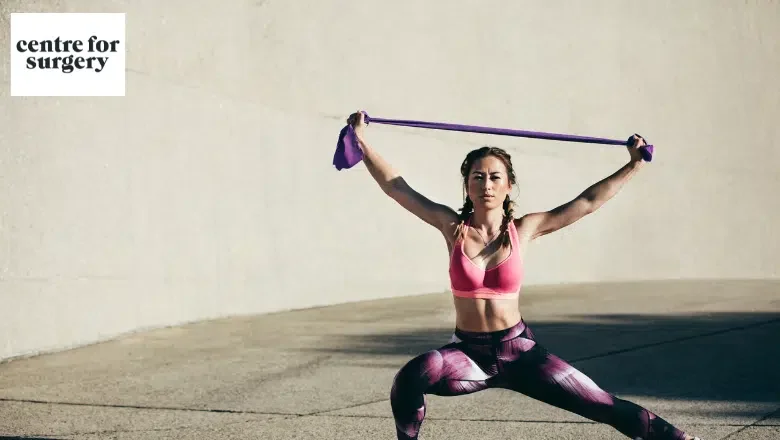Resuming Exercise After Breast Implant Surgery: Guidelines for a Safe Recovery
When patients at Centre for Surgery consider breast augmentation surgery, a frequent query they have for our Breast Experts and Plastic Surgeons is regarding the appropriate time to resume exercise post-surgery. This question often takes the form of, “When is it safe to return to the gym after implant surgery?”
The journey to a full recovery and achieving the best possible results is significantly influenced by diligently adhering to the guidelines provided by your surgeon. It’s crucial to allocate sufficient time for rest and healing, not just for the external incision scars, but also for the internal surgical alterations. One key piece of advice we give our patients is to avoid prematurely stressing the surgical site. This includes steering clear of early returns to strenuous gym routines or engaging in vigorous exercise.
The rationale behind this guidance is grounded in the risk of compromising your surgical results. Early physical strain, particularly on the incisions and the internal surgical work, can have detrimental effects. It’s possible to negate all the effort and care that went into your surgery by not allowing your body the time it needs to heal properly.
We understand the eagerness to return to normal activities, including exercise, but it’s essential to remember that your body’s recovery should be the top priority. Following your surgeon’s post-operative instructions to the letter will ensure a smoother and safer recovery, paving the way for lasting and satisfactory results from your breast implant surgery.
RELATED: Resuming Exercise After Breast Augmentation Surgery
Is It Advisable to Lift My Arms After Breast Augmentation Surgery?
In the initial stages post-surgery, it’s important to limit the movement of your arms. Specifically, our surgeons recommend keeping your arms below shoulder level for about two weeks. This precaution is vital for allowing the formation of a capsule around the implant, ensuring its secure placement. Lifting your arms above your shoulders too soon can risk displacing the implant.
The Impact of Exercise on Recovery After Breast Augmentation: Insights from UK Research
Research conducted in the UK has increasingly highlighted the medical benefits of early and appropriate exercise following breast augmentation surgery. These studies collectively emphasise how exercise can positively influence recovery, pain management, and quality of life for patients post-surgery.
One significant study focused on 200 breast cancer patients who had undergone reconstructive surgery. Initially, these patients experienced a brief period of shoulder immobilisation lasting for two weeks. Following this phase, they embarked on a self-directed exercise regimen. Throughout this period, various aspects such as shoulder mobility, pain intensity, overall quality of life, and the rate of complications were closely monitored. The findings were quite revealing. After one to two months, those who engaged in early rehabilitation with self-exercises showed notable improvements in shoulder flexibility, specifically in movements like flexion and abduction.
Another study delved into the effects of early range-of-motion exercises in breast cancer patients who had undergone mastectomies with immediate implant-based reconstructions. Remarkably, these patients began their exercise routines just a day after surgery, though initially limiting shoulder movement to ninety degrees. After a fortnight, they were divided into two groups: one allowed to perform unrestricted shoulder exercises within their pain threshold, and the other continuing with the limited ninety-degree range of motion. The outcome was clear – those in the unrestricted group experienced less pain, greater shoulder mobility, and improved upper limb function compared to their counterparts. This led researchers to conclude that for patients undergoing immediate implant-based reconstruction post-mastectomy, initiating exercise promptly can significantly aid in functional recovery and pain management.
Additionally, another study investigated the effects of breast augmentation on the pectoralis major muscle – a key muscle in the chest – in athletic women. This research involved 30 female athletes who engaged in regular weight training for a minimum of eight hours weekly. Post breast augmentation, these athletes were asked to complete a questionnaire evaluating their exercise performance, pain levels, and satisfaction with the aesthetic outcome of the surgery. Over half of the participants reported an enhanced ability to exercise without pain. Moreover, the majority expressed high levels of satisfaction with their breast augmentation, regardless of the implant’s placement.
These studies collectively underscore the importance and benefits of tailored exercise programmes following breast augmentation surgery. They highlight not just the enhancement in physical capabilities and pain reduction but also the positive impact on overall satisfaction and quality of life for the patients.












